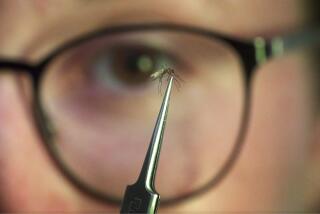Fungus sweeps across the country, killing bats
Reporting from Ruidoso, N.M. — More than 100 hibernating bats hang from the vaulted ceiling of a chilly gallery in central New Mexico’s Fort Stanton Cave, seemingly unaware of the lights from helmet lanterns sweeping over their gargoyle-like faces.
The mood is heavy with anxiety as biologists Marikay Ramsey and Debbie Buecher search for signs of white-nose syndrome, a novel, infectious and lethal cold-loving fungus that digests the skin and wings of hibernating bats and smudges their muzzles with a powdery white growth.
“These bats look fine, which is a relief,” U.S. Bureau of Land Management endangered animal specialist Ramsey said as she prepared to log the humidity and temperature of the cave in a hand-held computer. “But we still worry that the disease could hit New Mexico this winter or the next. If that happens, we may have to close every cave and abandoned mine in the state.”
Biologists across the nation are facing a similarly grim scenario. Since it was discovered in New York four years ago, the fungus has swept across 17 states as far west as Oklahoma, killing a million bats. A majority of the dead were little brown bats, which have lost an estimated 20% of their population in the northeastern United States over the last four years. The fungus seems to prefer the 25 species of hibernating bats, but each of the 45 species of bats in the United States and Canada may be susceptible to white-nose syndrome.
Geomyces destructans was first documented in 2007 in New York’s Howe Caverns, commercial attraction visited by thousands of tourists from around the world each year. As the disease began to spread, researchers learned that a similar fungal growth had long been seen on the faces and wings of hibernating bats in Europe.
Now scientists are scrambling to figure out whether the fungus was introduced by a bat or a caver from Europe. If it is from Europe, they wonder, has the fungus killed bats there or have they adapted to living with the pathogen? Or did the fungus already live in North America but recently mutate to become the virulent wildlife disease?
“It is unbelievably sad and disheartening, and we can’t seem to move fast enough to get ahead of it,” said U.S. Geological Survey wildlife biologist LeAnn White. “We may be looking at phenomenal losses across the country with unknown ecological consequences.”
Bats have always existed at close to the numbers seen prior to the arrival of white-nose syndrome, feasting on such night-flying insects as mosquitoes, which transmit West Nile virus, and agricultural pests damaging to cotton and corn crops. They also pollinate plants, including the saguaro cactus. “We don’t know what will happen if they disappear,” said USGS biologist Paul Cryan. A recent study published in Science estimates that the value of pest control provided by bats each year is at least $3.7 billion nationwide.
As the syndrome continues to spread westward along migratory flyways, Thomas Kunz and Jonathan Reichard of Boston University’s Center for Ecology and Conservation Biology have urged the U.S. Fish and Wildlife Service to list the little brown bat, one of the most common mammals in the United States, as endangered.
The listing would provide the greatest legal protections — on both public and private lands — for the chocolate-colored, mouse-sized insectivore which, the biologists are virtually certain, is facing regional extirpation in the northeastern United States within 15 years.
Greg Turner, an endangered animal specialist for the Pennsylvania Game Commission, knows the sickening feeling of discovering hundreds of carcasses of these nocturnal animals in caves he has monitored for decades. “There are a million bats in Pennsylvania alone, and half of them are dead,” he said. “I’d be surprised if the disease hasn’t taken up half the nation by the end of this winter.”
Hibernation, Turner pointed out, is essential for the survival of individual bats during a portion of the year when there are no insects to eat. It is also why the disease has been so successful. During hibernation, a bat’s body temperature drops to the ideal range for growth of the fungus.
“A mammalian fungus would be expected to have a restriction for cold growth because mammals require warmth, but that’s where the novelty of this fungus comes in,” said Carol Meteyer, a pathologist with the geological survey’s National Wildlife Health Center. “It occurs in caves and requires cold temperatures, and when a bat hibernates, it becomes the temperature of its environment.”
And because a bat’s immune system is suppressed during hibernation, its body does not fight off the fungus.
“So when I look at bat tissue under the microscope,” said Meteyer, “there are no signs of inflammatory response to defend the body from the infection. The body is not recognizing it as foreign.”
Scientists have considered using fungicides, but studies have shown they could kill other microbes in caves, perhaps setting off a chain of unintended consequences. Another option, placing heaters in caves, would disrupt bat hibernation, those studies found.
Killing infected animals would slow the spread of the disease but would not eliminate it because of the complexity of bat life, according to research conducted by Tom Hallam and Gary McCracken of the National Institute for Mathematical and Biological Synthesis at the University of Tennessee.
“It would be all but impossible to find and kill every infected bat,” Hallam said. “Yet, because of the size of bat colonies and the many arenas in which they interact — reproduction, hibernation, swarming, mother and pup activities — it would only take one infected bat to start it all over again.”
State and federal officials have already closed thousands of caves nationwide to prevent humans from spreading spores picked up on clothing and caving gear. But caves and abandoned mines are found on land governed by many agencies. Their response has been criticized as slow and disorganized.
“We need bold action and coordination at the highest levels of government,” said Mollie Matteson, a conservation advocate for the Center for Biological Diversity. “We probably will not have another chance to save these animals.”
In New Mexico, the Bureau of Land Management has closed 28 caves known to have significant bat populations. “We are not embracing the ‘close everything’ approach,” said BLM spokeswoman Donna Hummel, “because in a rural state like ours we need cavers to help us patrol and monitor caves on more than 13 million acres of terrain in our jurisdiction.”
Even though Carlsbad Caverns has no hibernating bats, the National Park Service has asked visitors there not to wear clothing or shoes that may have been in a cave or mine in states known to harbor the fungus.
Elsewhere, the fish and wildlife service urges cavers to decontaminate clothing and gear before leaving an affected region. The U.S. Forest Service has closed caves in its Northeastern, Midwestern and Rocky Mountain regions and is considering a plan to close caves in New Mexico that have significant bat populations, including in areas near Carlsbad. Federal land managers in California and Arizona have yet to close caves.
Assessing the health of the bats inside caves entails a harrowing descent through cracks in the bedrock of remote canyons and desert flatlands, through narrow, undulating passages sometimes lined with rat nests, black widow spiders and rattlesnake dens.
On a wintry weekday, Ramsey and BLM cave specialist Mike Bilbo visited Ladrone Cave, a pitch-dark labyrinth of awkward twists and turns about 70 miles south of Albuquerque.
They wedged themselves through a crevice and down a slope, their stooped bodies only a few feet from the limestone ceiling. Bat excrement — guano — filled the dank air with the sharp smell of ammonia. Travertine and calcite crystals in crevices sparkled like snowflakes in the lights of their helmet lanterns.
Ramsey spotted something on the ground. It was the remains of two dead bats.
Raising one of the carcasses by the tip of its wing for a closer look, Ramsey said, “It seems to be free of white-nose syndrome, but we’ll take a closer look in the laboratory to determine exactly why it died.”
As a precautionary measure, Bilbo posted a warning sign near the grotto’s entrance: “Cave temporarily closed due to white-nose syndrome.”
More to Read
Sign up for Essential California
The most important California stories and recommendations in your inbox every morning.
You may occasionally receive promotional content from the Los Angeles Times.











